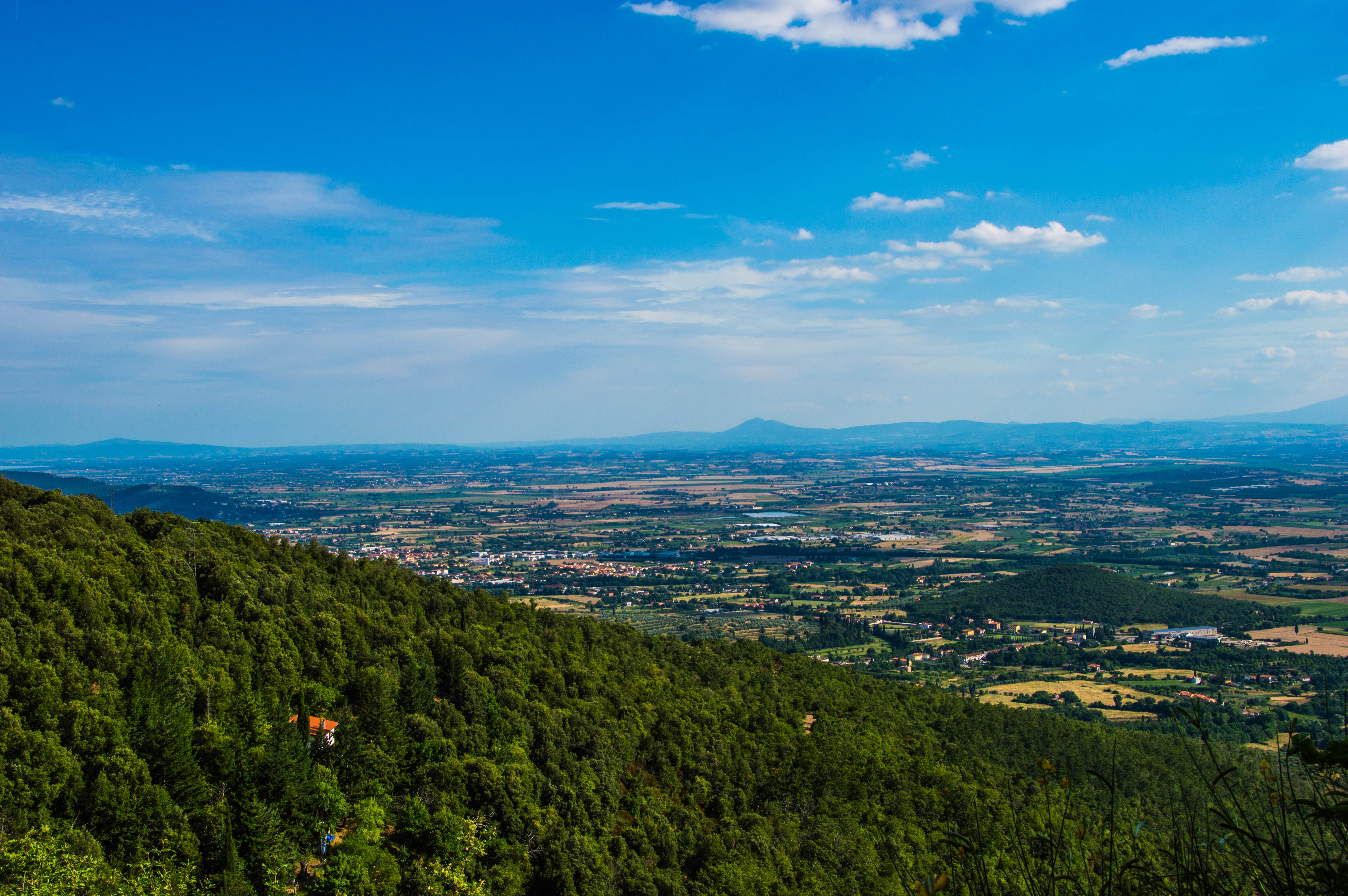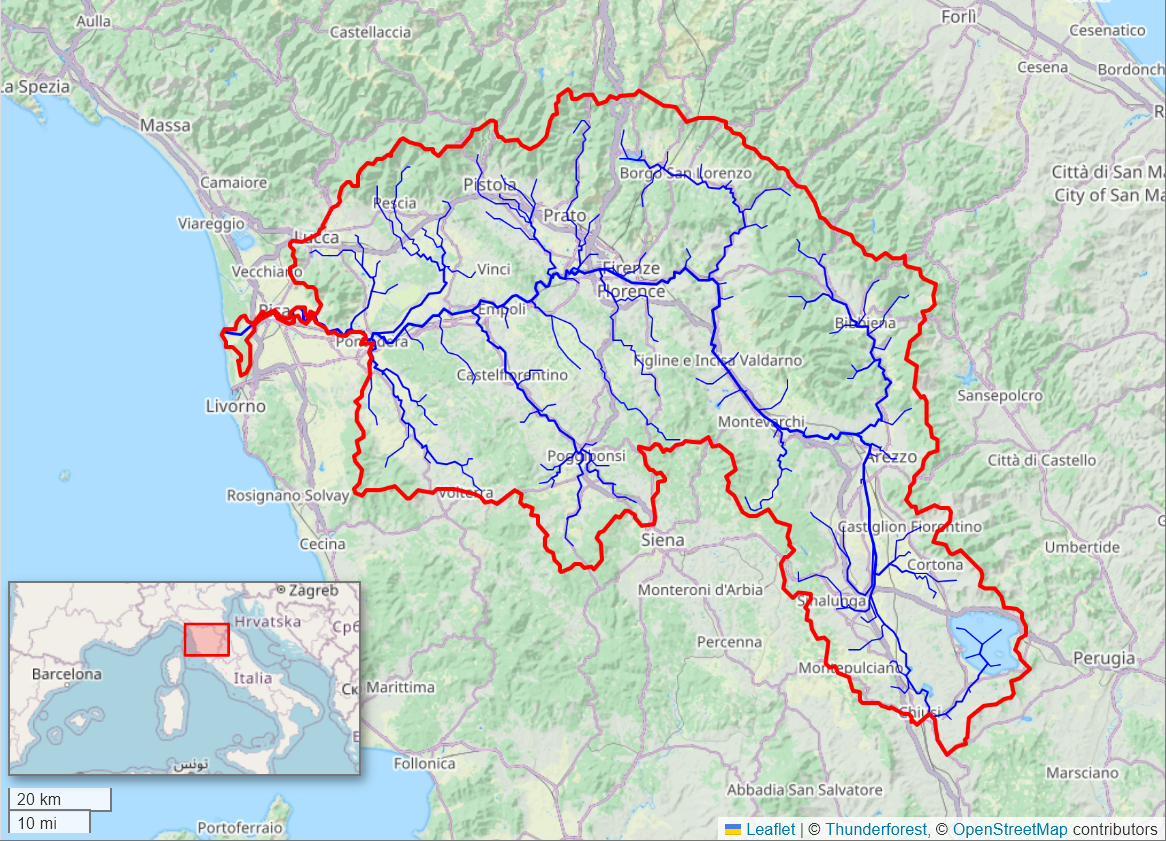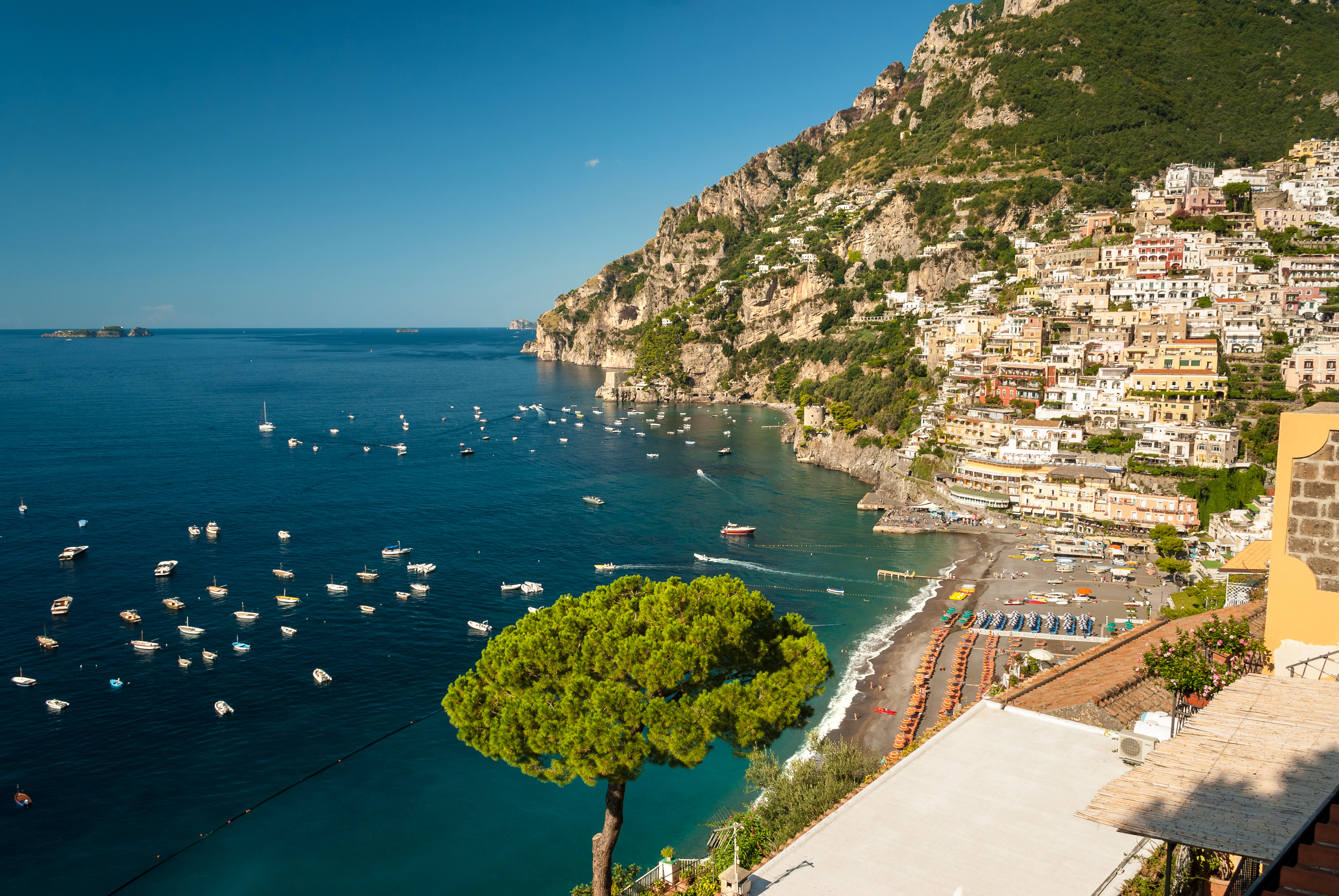|
Valdichiana
The Val di Chiana, Valdichiana, or Chiana Valley, formerly Clanis Valley, is a tectonic valley of central Italy, whose valley floor consists of important alluvial residues filled up since the 11th century, lying on the territories of the provinces of Arezzo and Siena in Tuscany and the provinces of Perugia and Terni in Umbria. Morphological formation of the Clanis (Chiana) Valley The valley, of tectonic origin with extension on the western side and compression on the eastern one, was mainly formed during the Miocene. In the Pliocene it was almost entirely submerged by the great Pliocene sea. Once it had withdrawn, in the upper Villafranchiano (about two million years ago) central Italy hosted large lakes, including that of the Chiana basin which was short-lived as it was drained (at the beginning of the Pleistocene) by the erosion of the hilly threshold of its waters, to take the form of a canyon crossed by a river, tributary of the waters of Lake Trasimeno (whose formation ended ... [...More Info...] [...Related Items...] OR: [Wikipedia] [Google] [Baidu] |
Chiusi
Chiusi ( Etruscan: ''Clevsin''; Umbrian: ''Camars''; Ancient Greek: ''Klysion'', ''Κλύσιον''; Latin: ''Clusium'') is a town and ''comune'' in the province of Siena, Tuscany, Italy. History Clusium (''Clevsin or Camars'' in Etruscan) was one of the more powerful cities in the Etruscan League of twelve peoples. Chiusi came under the influence of Rome in the 3rd century BC and was involved in the Social War. According to a Roman historical tradition Arruns of Clusium invited Gaul mercenaries from the Po Valley into Clusium to seek revenge for a domestic conflict concerning his wife. However the Gauls sacked the city instead and settled in the region. In 540 AD it was occupied by the Ostrogoths and was later seat of a Lombard duchy. From the 11th century it was under the rule of the local bishop, and was later contended for by Orvieto and, from 1231, Siena, belonging to the latter until 1556, when it was annexed to the Grand duchy of Tuscany. The region was devastat ... [...More Info...] [...Related Items...] OR: [Wikipedia] [Google] [Baidu] |
Province Of Siena
The province of Siena (, ) is a Provinces of Italy, province in the Tuscany region of Italy. Its capital is the city of Siena. It has 259,826 inhabitants. Geography The province is divided into seven historical areas: * Alta Val d'Elsa * Chianti senese * The urban area of (Monteriggioni and Siena) * Val di Merse * Crete Senesi, Crete Senesi Val d'Arbia * Val di Chiana senese * Val d'Orcia and Monte Amiata The area is a hilly one: in the north is Chianti (region), Colline del Chianti; Monte Amiata is the highest point at ; and in the south is Monte Cetona. To the west are the Colline Metallifere (), whilst the Valdichiana lies to east. Historically, the province corresponds to the northeastern portion of the former Republic of Siena. The chief occupations are agricultural (wheat, grapes and fruit) and silk culture. The wine known as Chianti is produced here as well as in other parts of Tuscany: the Chianti Colli Senesi, however, is limited to this province. Apart from the cit ... [...More Info...] [...Related Items...] OR: [Wikipedia] [Google] [Baidu] |
Arno
The Arno is a river in the Tuscany region of Italy. It is the most important river of central Italy after the Tiber. Source and route The river originates on Monte Falterona in the Casentino area of the Apennines, and initially takes a southward curve. The river turns to the west near Arezzo passing through Florence, Empoli and Pisa, flowing into the Ligurian Sea at Marina di Pisa. With a length of , it is the largest river in the region. It has many tributaries: Sieve at long, Bisenzio at , Ombrone Pistoiese at , and the Era, Elsa, Pesa, and Pescia. The drainage basin amounts to more than and drains the waters of the following subbasins: *The Casentino, in the province of Arezzo, formed by the upper course of the river until its confluence with the Maestro della Chiana channel. *The Val di Chiana, a plain drained in the 18th century, which until then had been a marshy area tributary of the Tiber. *The upper Valdarno, a long valley bordered on the east by the Pr ... [...More Info...] [...Related Items...] OR: [Wikipedia] [Google] [Baidu] |
Tevere
The Tiber ( ; ; ) is the List of rivers of Italy, third-longest river in Italy and the longest in Central Italy, rising in the Apennine Mountains in Emilia-Romagna and flowing through Tuscany, Umbria, and Lazio, where it is joined by the River Aniene, to the Tyrrhenian Sea, between Ostia (Rome), Ostia and Fiumicino. It Drainage basin, drains a basin estimated at . The river has achieved lasting fame as the main watercourse of the city of Rome, which was founded on its eastern banks. The river rises at Mount Fumaiolo in Central Italy and flows in a generally southerly direction past Perugia and Rome to meet the sea at Ostia (town), Ostia. The Tiber has advanced significantly at its mouth, by about , since Roman times, leaving the ancient port of Ostia Antica (archaeological site), Ostia Antica inland."Tiber River". ''Encyclopædia Britannica''. 2006 However, it does not form a proportional river delta, delta, owing to a strong north-flowing sea current close to the shore, d ... [...More Info...] [...Related Items...] OR: [Wikipedia] [Google] [Baidu] |
Rome
Rome (Italian language, Italian and , ) is the capital city and most populated (municipality) of Italy. It is also the administrative centre of the Lazio Regions of Italy, region and of the Metropolitan City of Rome. A special named with 2,746,984 residents in , Rome is the list of cities in the European Union by population within city limits, third most populous city in the European Union by population within city limits. The Metropolitan City of Rome Capital, with a population of 4,223,885 residents, is the most populous metropolitan cities of Italy, metropolitan city in Italy. Rome metropolitan area, Its metropolitan area is the third-most populous within Italy. Rome is located in the central-western portion of the Italian Peninsula, within Lazio (Latium), along the shores of the Tiber Valley. Vatican City (the smallest country in the world and headquarters of the worldwide Catholic Church under the governance of the Holy See) is an independent country inside the city boun ... [...More Info...] [...Related Items...] OR: [Wikipedia] [Google] [Baidu] |
Tyrrhenian Sea
The Tyrrhenian Sea (, ; or ) , , , , is part of the Mediterranean Sea off the western coast of Italy. It is named for the Tyrrhenians, Tyrrhenian people identified with the Etruscans of Italy. Geography The sea is bounded by the islands of Corsica and Sardinia (to the west), the Italian Peninsula (regions of Tuscany, Lazio, Campania, Basilicata, and Calabria) to the north and east, and the island of Sicily (to the south). The Tyrrhenian Sea also includes a number of smaller islands like Capri, Elba, Ischia, and Ustica. The maximum depth of the sea is . The Tyrrhenian Sea is situated near where the African Plate, African and Eurasian Plates meet; therefore mountain chains and active volcanoes, such as Mount Marsili, are found in its depths. The eight Aeolian Islands and Ustica are located in the southern part of the sea, north of Sicily. Extent The International Hydrographic Organization defines the limits of the Tyrrhenian Sea as follows: * In the Strait of Messina: A line ... [...More Info...] [...Related Items...] OR: [Wikipedia] [Google] [Baidu] |
Holocene
The Holocene () is the current geologic time scale, geological epoch, beginning approximately 11,700 years ago. It follows the Last Glacial Period, which concluded with the Holocene glacial retreat. The Holocene and the preceding Pleistocene together form the Quaternary period. The Holocene is an interglacial period within the ongoing Ice age, glacial cycles of the Quaternary, and is equivalent to Marine isotope stages, Marine Isotope Stage 1. The Holocene correlates with the last maximum axial tilt towards the Sun of the Earth#Axial tilt and seasons, Earth's obliquity. The Holocene corresponds with the rapid proliferation, growth, and impacts of the human species worldwide, including Recorded history, all of its written history, technological revolutions, development of major civilizations, and overall significant transition towards urban culture, urban living in the present. The human impact on modern-era Earth and its ecosystems may be considered of global significance for th ... [...More Info...] [...Related Items...] OR: [Wikipedia] [Google] [Baidu] |
Chiusi Scalo
Chiusi Scalo is a village in Tuscany, central Italy, administratively a frazione of the comune of Chiusi, province of Siena. At the time of the 2001 census its population was 3,892. Monuments Church of Santa Maria della Pace Bishop Giuseppe Conti laid and blessed the first stone of the church on 1 August 1919, in response to the village's growing population. The church was built on land owned by the Schools for reading, writing, and arithmetic, established by Bishop Giuseppe Pannilini in 1823. Construction was completed in August 1926, and on 7 September, the church was consecrated and dedicated to ''Santa Maria della Pace'' by Bishop Conti. The church was later established as a parish in October 1930 but suffered significant damage from Allied bombings during World War II World War II or the Second World War (1 September 1939 – 2 September 1945) was a World war, global conflict between two coalitions: the Allies of World War II, Allies and the Axis powers. World ... [...More Info...] [...Related Items...] OR: [Wikipedia] [Google] [Baidu] |
Province Of Terni
The province of Terni () is the smaller of the two provinces in the Umbria region of Italy, comprising one-third of both the area and population of the region. Its capital is the city of Terni. The province came into being in 1927, when it was carved out of the original unitary province of Umbria. The province of Terni has an area of 2,122 km2 and a population of 228,836 (2016). There are 33 ''comuni'' (: ''comune'') in the province. In June 2006, the only ''comuni'' (municipalities) with a population over 10,000 were , , |
Orvieto
Orvieto () is a city and ''comune'' in the Province of Terni, southwestern Umbria, Italy, situated on the flat summit of a large butte of volcanic tuff. The city rises dramatically above the almost-vertical faces of tuff cliffs that are completed by defensive walls built of the same stone. History Etruscan era The ancient city (''urbs vetus'' in Latin, whence "Orvieto"), populated since Etruscan civilization, Etruscan times, has usually been associated with Etruscan Velzna, but some modern scholars differ. Orvieto was certainly a major centre of Etruscan civilization; the archaeological museum (Museo Claudio Faina e Museo Civico) houses some of the Etruscan artifacts that have been recovered in the immediate area. A tomb in the Orvieto Cannicella necropolis bears the inscription ''mi aviles katacinas'', "I am of Avile Katacina"; the tomb's occupant thus bore an Etruscan-Latin first name, Aulus (other), Aulus, and a family name that is believed to be of Celtic origin ... [...More Info...] [...Related Items...] OR: [Wikipedia] [Google] [Baidu] |
Orte
Orte is a town, ''comune'', former Catholic bishopric and Latin titular see in the province of Viterbo, in the central Italian region of Lazio, located about north of Rome and about east of Viterbo. Geography Orte is situated in the Tiber Valley on a high tuff (rock), tuff cliff, encircled to North and East from a handle of the Tevere river. It is an important road and rail hub. History The Etruscans inhabited the area from the 6th century BC and called it Hurta, as testified by the findings in a necropolis nearby, now preserved in the Vatican Museums. Two major battles between Etruscans and Romans (310 and 283 BC) were fought nearby on the shores of the Lake Vadimo, Vadimone lake. The Romans were victorious both times. The Romans domination made it the municipality of ''Horta'' (also ''Hortanum''). Under the rule of Augustus it received numerous public works. Because of its strategic position, Orte was occupied in succession by the Ostrogoths, the Byzantine Empire, Byzan ... [...More Info...] [...Related Items...] OR: [Wikipedia] [Google] [Baidu] |






